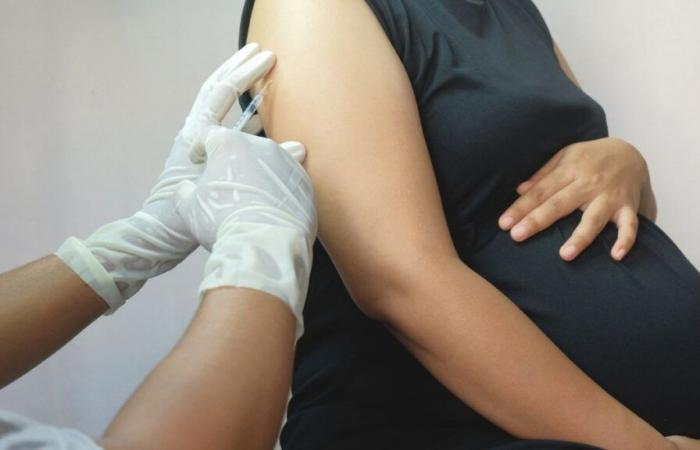Context
Whooping cough, a contagious respiratory disease caused by the bacterium ‘Bordetella pertussis’, is endemic, with larger epidemics expected every three to five years. After a few years of limited circulation in Europe, particularly during the COVID-19 pandemic, an increase in cases of whooping cough was noted in 2023 and 2024. The risk of morbidity and mortality is particularly high for infants under 6 months unvaccinated or partially vaccinated. National pertussis vaccination programs in European countries therefore aim to reduce morbidity and mortality among newborns. In this context, maternal vaccination appears to be a very effective approach to achieving this goal, with estimated reductions in pertussis risk ranging from 70 to 95%.
Since 2023, whooping cough has experienced a resurgence on French national territory with very significant increases in cases observed in the first quarter of 2024, which have intensified in recent months. In order to reduce the risk of serious forms in newborns and infants, the High Authority of Health (HAS) has recommended since 2022 the vaccination of pregnant women against whooping cough from the second trimester of pregnancy, favoring the period between 20 and 36 weeks of amenorrhea (SA). This measure is the most effective in protecting the infant from birth thanks to the transplacental transfer of maternal antibodies. She also recommends that vaccination be carried out during each pregnancy, even if vaccination has already taken place previously. The HAS, faced with this context of a marked increase in cases of whooping cough, with a particularly high number of deaths among newborns and infants, was requested in June 2024 by the Ministry of Health to strengthen vaccination recommendations.
Thus, since July 2024, the HAS has recommended a booster vaccination for all people likely to have close contact with newborns and infants under 6 months old, if the last injection received was more than 5 years ago.
Goals
The objective of this work is to estimate the vaccination rate against whooping cough among pregnant women in France in the epidemic context of 2024, as well as to study the characteristics of these women and the factors influencing vaccination.
Results
In total, taking into account all pregnancy declarations recorded in the maternity history table on the date of 1is October 2024, 386,712 women had started their pregnancy between August 1, 2023 and March 31, 2024, with nearly 50,000 pregnancies declared per month in France. Among them, 59.4% had given birth on the date of 1is October 2024. The vaccination rate against whooping cough in this population was 63.2% (or 244,422 women) of which more than 90% had been vaccinated between the 18th and the 34th week of pregnancy. The two most used vaccines were REPEVAX® (67.4%) and BOOSTRIXTETRA® (32.2%).
Among the 304,534 women who had reached at least 34 weeks of pregnancy at the end of follow-up date, set for October 1, 2024, the vaccination rate was 65.4%. After differentiating women whose pregnancy began between August and December 2023 from those who began in 2024, the vaccination rates were 63.8% and 72.4%, respectively.
Very strong regional disparities were observed regarding pertussis vaccination coverage among these women. Indeed, the rates were significantly higher than the national average in regions located in the north and west of France such as Pays de la Loire (80.9%), Brittany (80.3%), Normandy (79.9%), New Aquitaine (75.4%) and Hauts-de-France (72.5%). On the other hand, the lowest rates were observed in the overseas departments (35.1% including 15.9% in Guadeloupe, 8.1% in Martinique and 5.1% in Guyana), as well as in Corsica (46.2%), in Provence-Alpes-Côte d’Azur (58.7% with 31.1% in the Alpes-de-Haute-Provence department), in Ile-de-France (59.3% with very varied rates ranging from 46.6% for Val-d’Oise at 75.1% for Paris), in Occitanie (61.2%) and in the Grand Est (61.4%)).
Furthermore, socio-economic indicators highlighted a slight imbalance between women who had been vaccinated against whooping cough during pregnancy and those who had not. In fact, vaccinated women benefited less from complementary solidarity health insurance (16.7% vs. 32.1%), had less recourse to consultations with PMI services (3.9% vs. 4.4%), were more often from more advantaged municipalities (FDep 1is quintile (less disadvantaged): 22.1% vs. 16.6%) and lived in municipalities offering better localized potential accessibility to general practitioners (APL MG 4th quartile : 26,2% vs. 22,5%).
Conclusion
These results show that vaccination of women during pregnancy against whooping cough, recommended by the WHO and already implemented by around thirty countries around the world for at least ten years, was widely followed during the 2023/2024 epidemic. , despite its non-obligatory nature. Indeed, the vaccination rate has experienced a sharp increase in France each year since 2021. According to data from the Epi-Mères (pregnancies-children) register constructed by EPI-PHARE using the SNDS, the vaccination rates were respectively around 41%, 12%, and 2% for the years 2023, 2022, and 2021. This vaccination rate of pregnant women subsequently reached around 65% in the epidemic context of 2023-2024.
The sharp increase in this high coverage rate seems to demonstrate the effectiveness of the awareness-raising actions of the State and Health Insurance among pregnant women. However, actions aimed at both reducing disparities at the regional level and improving the level of vaccination coverage in certain departments are still necessary.






